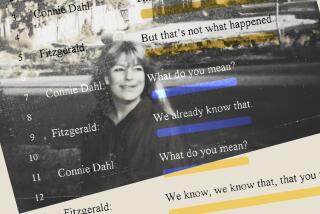Video Cameras Can Help Bring Justice More Sharply Into Focus
Just as DNA testing is revolutionizing the criminal justice system, the video camera -- a staple of the television industry and of many households -- is being called on to increase the transparency of that system.
DNA testing has revolutionized forensics by turning microscopic evidence into irrefutable proof. Its extraordinary power comes from its ability to use advanced and objective science and technology to free the wrongly convicted and confirm the guilt of others. That power provides great reassurance, but its pivotal role in reversing several high-profile convictions also points out that there are underlying flaws in the criminal justice process and that innocent people do sometimes get convicted.
It’s tempting to think that DNA testing will right every wrong. Unfortunately, DNA can solve only a relatively small number of cases, generally those involving the presence of bodily fluids, hair or skin. They are often highly visible cases -- murders and sexual assaults, in particular -- but the vast majority of crimes have to be solved without it. The challenge to the justice system is to reduce the points of uncertainty in solving crimes.
One point of uncertainty involves the process of interrogation and confession, and that’s where the call for video cameras is being made. Just as they do in courtrooms across the nation, video cameras have the power to make clear precisely what goes on. If a confession is coerced through improper interrogation, it will be known.
Allegations of coerced confessions, particularly involving teenagers, have repeatedly surfaced, most recently in the case of the New York City teenagers convicted in the 1989 rape of a Central Park jogger.
The concept of confessing to a crime that you did not commit seems baffling, but a surprising number of teenagers do it. Once arrested and separated from family and friends, they become frightened and disoriented. A desire to do whatever is necessary to minimize the problem can cause them to falsely confess.
The case of Michael Crowe, a 14-year-old from Escondido, Calif., arrested in 1998 for the murder of his 12-year-old sister, is a powerful example.
From the outset, the police were suspicious of his reaction to his sister’s death and did not fully investigate another significant lead: a vagrant who was arrested in the neighborhood with blood on his clothes. Under intense police pressure, Crowe confessed.
Fortunately, the police taped both the interrogation of Crowe and his confession. When those tapes were later shown to a judge, it became apparent that the confession had been coerced.
Crowe was ultimately released, but only after he and his family were put through an unimaginable ordeal. A DNA test later revealed that the blood on the vagrant’s clothes matched that of Crowe’s sister.
The solution to the problem of coerced confessions by teenagers is to make the system more transparent.
If the interrogations and confessions of juveniles are routinely videotaped, any coercion probably will be revealed. If the police act properly, any suggestions that they exerted undue pressure will be refuted.
In the Central Park jogger case, the police may now wish that the teenagers’ interrogations had been taped along with their confessions. Without complete tapes, suspicion of coercion may grow.
Only two states -- Alaska and Minnesota -- require the taping of interrogations. The taping of confessions is more common. But the taping of confessions does not reveal what went on before; it does not expose any coercion that may have taken place.
Police departments are typically resistant to the taping of interrogations. It is seen as an additional level of bureaucracy and a restriction on the leverage -- not physical but emotional -- that may be necessary to get the truly guilty to confess. Clearly not everyone who confesses is innocent.
In the case of juveniles, however, it seems hard to argue against taped interrogations and confessions.
The case of Michael Crowe is evidence enough.
More to Read
Inside the business of entertainment
The Wide Shot brings you news, analysis and insights on everything from streaming wars to production — and what it all means for the future.
You may occasionally receive promotional content from the Los Angeles Times.









